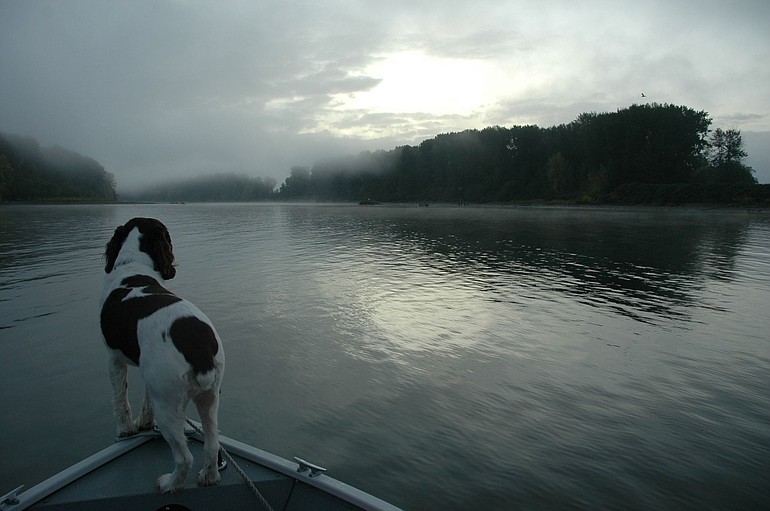Eighteenth-century English author Samuel Johnson once wrote: “A fishing pole has a hook at one end and a fool at the other.”
If so, there are lots of fools in Southwest Washington and northern Oregon. There were 400,000 fishing trips last year just in pursuit of sturgeon, salmon and steelhead and just in the lower Columbia River, even in the face of many conservation restrictions.
http://wdfw.wa.gov
http://www.ifish.net
http://www.washingtonlakes.com
http://www.gamefishin.com
And for every angler on the Columbia with an expensive boat and fancy gear, there are many more dunking salmon eggs, worms and other baits. Those fishermen are in pursuit of trout, bass or anything else that will bite. They are at Klineline Pond, Lacamas Lake, Battle Ground Lake, Swift Reservoir or perhaps one of the lakes high in the Cascade Mountains.
There’s even a bounty fishery during the summer where anglers are paid to catch northern pikeminnow, a predator of young steelhead and salmon.
<a href="http://wdfw.wa.gov">http://wdfw.wa.gov</a>
<a href="http://www.ifish.net">http://www.ifish.net</a>
<a href="http://www.washingtonlakes.com">http://www.washingtonlakes.com</a>
<a href="http://www.gamefishin.com">http://www.gamefishin.com</a>
Someone is fishing somewhere every day in Southwest Washington, where some waters never close.
Clark County has water on three sides, and thus it’s no surprise there is plenty of fishing opportunity locally. Include nearby Skamania and Klickitat counties and there are 15 species available for anglers.
Those include chinook (three types) and coho salmon, steelhead (two types), shad, sturgeon, northern pikeminnow, kokanee, trout (five types), bass (two types), tiger musky, bullheads, bluegill-sunfish, crappie (two types), yellow perch and walleye.
But before doing any fishing, an angler needs a state license. A resident freshwater fishing license costs $24. A combination license, which also allows saltwater fishing and shellfish digging, costs $46.20. A one-day fishing license costs $8.18.
Dealers who sell the licenses for the state are allowed to tack on a service charge.
Washington’s licensing cycle begins April 1 and ends March 30. Don’t ask why; it’s a long and complicated story.
Here’s a look at a few of the major fisheries locally:
o Chinook — Columbia River chinook salmon are the premier fish of the region. Spring chinook, which arrive in March, April and May, are, arguably, the best salmon in the world. Summer chinook, which migrate in mid-June and July, are a close second. Fall chinook enter the Columbia from August into November, peaking in September.
Fishing for chinook is managed tightly to avoid overharvest and to share the catch between sport, commercial and tribal groups. Seasons open and close on short notice and the regulations are often convoluted.
Most chinook fishing is done by either trolling herring, spinners or plugs, or from an anchored boat during outgoing tides. Look at the river in early April or late August-early September, and “hoglines” of boats at anchor are common.
Spring chinook return to the Willamette, Cowlitz, Kalama, Lewis, Wind, Little White Salmon and Klickitat rivers too.
Summer chinook are main-stem fish, passing through to the upper Columbia. Fall chinook are caught in the lower Columbia and many tributaries.
Chinook range from 10 to 40 pounds.
o Coho — Smaller than chinook, coho are caught mostly in the ocean off the Washington and Oregon coasts, plus in some tributaries, including the Cowlitz and North Fork of the Lewis. They also bite at Buoy 10, the lower 16 miles of the Columbia, but not much upstream of the Astoria-Megler Bridge.
Coho range from about 6 to 18 pounds. They are taken in July and August off the coast, during late August and early September at Buoy 10, and in September, October and November in the tributaries.
Coho fishing in the Columbia upstream of the Astoria bridge is minor, and happens mostly off the mouths of the Cowlitz, Washougal, Sandy and Klickitat rivers. About 5,500 coho were caught upstream of Astoria in 2009.
o Steelhead — Winter steelhead arrive mostly in December and January. They are fished almost exclusively in the tributary streams, both by bank fishermen and boaters in drift boats.
Summer steelhead enter the Columbia and tributaries from April into October, but peak in June, July and August. They are caught both in the main Columbia and many tributaries including the Cowlitz, Kalama, Lewis, Washougal, White Salmon and Klickitat rivers, plus in Drano Lake.
Although only 4 to 15 pounds, steelhead are great fighters.
o Sturgeon — These slow-growing bottom dwellers live in the Columbia and connected waters, such as the lower Willamette and lower Cowlitz rivers.
There are completely different sets of rules for fishing sturgeon in the estuary (downstream of Cathlamet) and the river between Cathlamet and Bonneville Dam. Each reservoir in the mid-Columbia has a quota, and closes once the quota has been caught.
Lower Columbia sturgeon must be at least 38 inches long to keep and no longer than 54 inches, measured from the tip of the snout to the fork in the tail. There’s also a five-fish annual limit.
Shore fishermen do well, particularly in fall, near Bonneville Dam, but sturgeon angling is best by boat. There’s a huge boat fishery in the Chinook-Ilwaco-Astoria area during late May and June.
o Trout — Washington stocks thousands of rainbow, cutthroat and brown trout in Southwest Washington lakes.
Klineline Pond in Salmon Creek Park was planted with more than 30,000 trout in 2009. Other numbers were 60,000 at Swift Reservoir, 22,000 at Lacamas Lake, 29,000 at Battle Ground Lake, 23,000 in Horseshoe Lake, 22,00 in Horsethief Lake and 6,200 in Goose Lake, a small mountain lake.
Forty-two lakes or streams in the six southwest counties were stocked last year.
So while salmon, steelhead and sturgeon get the attention, there are more fishing trips annually for trout. They are the bread-and-butter of the ordinary angler.
Trout lakes are close to home, most have shore access and many have boat ramps. Inexpensive gear and bait are all that’s necessary to outwit hatchery-origin trout.




